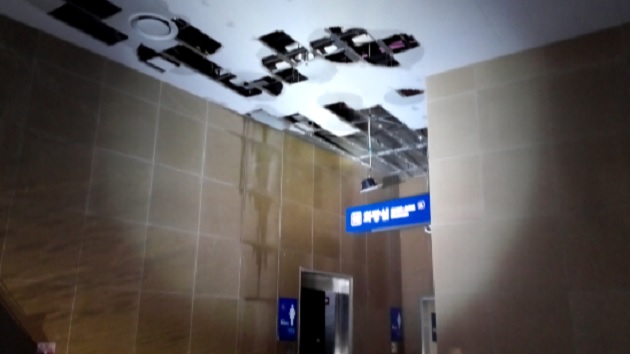
The international terminal of the Jeju Port experienced severe water leakage when typhoons Chaba and Soulik hit the island in 2016 and 2018, respectively.
Since then, problematic sites have been patched up, but the same problem reoccurs whenever there is rain.
It has been recently discovered that the construction of the port did not follow the original building plans. This is a violation of the Building Act.
Todd Thacker reports.
Whenever Jeju experiences a typhoon or heavy rain, the roof of the international passenger terminal at Jeju Port leaks.
Construction on the international terminal was completed in 2015. But right after it opened, the ceiling leaked when it rained, prompting repair work the following year.
The ceiling has seen intermittent repairs over the last five years. But recently, serious problems in the work have been uncovered.
Three areas of the ceiling haven't been built to the specifications detailed in the approved plans.
In the plans, roof ridges were specified. However, they have not been installed.
The width of the rainwater drainage system on the roof is nearly 30 centimeters narrower than planned. It was intended to be 162 centimeters in width.
Waterproofing work was also not completed.
These are significant factors in the frequent roof leakages.
Construction and repair work at the port was approved based on the specifications laid out in the plans. Failure to do so is a violation of the Building Act.
Apart from these violations, the bigger problem is that the roof can no longer be repaired.
Any further modifications to the roof structure will require that it be removed and replaced. In reality, that’s nearly impossible.
The province and the construction company have agreed to extend the term of guarantee by three years and carry out supplementary work on the international terminal.
This decision is proving controversial.
Since the legal liability of the construction company has not been invoked, this means that once the term of guarantee has expired, taxpayers will be on the hook for the cost of future repairs.
Up until now, some 40 billion won has gone into the problem at the port, with no fundamental solution in sight. This shows that further inspections of government-ordered work ? including at Jeju Port ? are needed to determine the extent of lax construction practises islandwide.
Todd Thacker, KCTV






